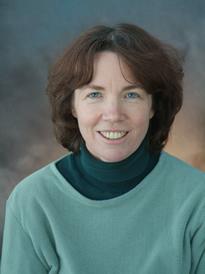Moira Ferguson

My interests are focused on understanding the genetics and evolution of complex traits. This was nurtured through B.Sc. and M.Sc. degrees at the University of Guelph where I received my first opportunities to investigate the genetics of phenotype in fishes. My continued fascination with this area prompted me to leave Canada and complete my Ph.D. degree under the direction of Fred Allendorf at the University of Montana. Most recently I apply basic information on the genetic architecture of important traits such as body size and age at maturation in Arctic charr, Atlantic salmon and rainbow trout to help solve problems facing the aquaculture industry.
- B.Sc. - Guelph 1979
- M.Sc. - Guelph 1981
- Ph.D. - Montana 1986
My research program focuses on understanding the genetic basis of evolutionary change. In particular I am concentrating on two major components of the evolutionary process. Firstly, I study how genetic differences among individuals lead to variation in the numbers and survival of their offspring (fitness). Secondly, I determine how those genetic differences can become partitioned between populations when they begin to diverge genetically into different species. Salmonid fishes (Atlantic salmon, Arctic charr, rainbow trout, brook charr) continue to be the models for most of this work because their biology makes them interesting candidates for genetic analysis. To address the first component, I am studying the action of natural selection to determine how variation among individuals in measurable traits (phenotypes) leads to differences in the numbers and survival of their offspring. However, to understand how this selection might drive the evolution of phenotypes it is also necessary to appreciate how genetic differences among individuals result in phenotypic differences. I therefore examine the genetic bases of phenotypic traits, both by determining the relative contributions of genetic and environmental effects to their variation, and by identifying regions of the genome that affect their expression. This information is being integrated into the selective breeding programs of several economically important species for aquaculture. Comparative analyses are being done to examine the fate of genes after genome reorganization. Conventional approaches for locating important genes within the genome require families of known brothers and sisters to be used in laboratory-based studies. I am also employing a novel approach in which genetic information is used to reconstruct family relationships in wild populations so that the genes affecting phenotypes can subsequently be identified. To address the second component I examine different forms (morphs) of Arctic charr that differ in both appearance and ecology, and live together in Icelandic lakes. By studying genetic variation in natural populations, and also by carrying out long-term laboratory and field experiments I use these fish to answer questions on the role of such physical variation in promoting the formation of groups that do not mate with each other. In particular I am determining the way in which these different forms might have arisen, and also investigating the role of such forms in the origin of new species. Finally, inventories of genetic markers in economically important species (walleye, cod, sturgeon, trout, charr) are being used to answer questions relevant to their management and conservation.
- Kuettner, E., K.J. Parsons, A.A. Easton, S. Skulason, R.G. Danzmann and M.M. Ferguson. 2014. Hidden genetic variation evolves with ecological specialization: the genetic basis of phenotypic plasticity in Arctic charr ecomorphs. Evolution and Development. 16:247-257.
- Allen, M.S., M.M. Ferguson, and R.G. Danzmann. 2014. Molecular markers for variation in spawning date in a hatchery population of rainbow trout (Oncorhynchus mykiss). Marine Biotechnology. 16:289-298.
- Norman, J.D., M.M. Ferguson and R.G. Danzmann. 2014. Transcriptomics of salinity tolerance capacity in Arctic charr (Salvelinus alpinus): A comparison of gene expression profiles between divergent Q. Physiological Genomics. 46:123-137.
- Kocmarek, A.L., M.M. Ferguson and R.G. Danzmann. 2014. Differential gene expression in small and large rainbow trout derived from two seasonal spawning groups. BMC Genomics. 15: Article 57.
- Chiasson, M.A., C.D. Quinton, R.G. Danzmann and M.M. Ferguson. 2013. Comparative analysis of genetic parameters and quantitative trait loci for growth traits in Fraser strain Arctic charr (Salvelinus alpinus) reared in brackish water environments. Journal of Animal Science. 91:2047-2056.
- Norman, J.D., M. Robinson, B. Glebe, M.M. Ferguson and R.G. Danzmann. 2012. Genomic arrangement of salinity tolerance QTL in salmonids: A comparative analysis of Atlantic salmon (Salmo salar) with Arctic charr (Salvelinus alpinus) and rainbow trout (Oncorhynchus mykiss). BMC Genomics. 13:420.
- Weese, D., M.M. Ferguson and B.R. Robinson. 2012. Contemporary and historical evolutionary processes interact to shape patterns of within-lake phenotypic divergences in polyphenic pumpkinseed sunfish, Lepomis gibbosus. Ecology and Evolution. 2:574-592.
- Kuettner, E., J. Nilsson, S. Skulason, S. Gunnarsson, M.M. Ferguson and R.G. Danzmann. 2012. Intraspecific sex-chromosome polymorphisms in Arctic charr and their shared interspecific homologies. Genome. 54:852-861.
- Norman, J.D., B. Glebe, R.G. Danzmann and M.M. Ferguson. 2011. The genetic basis of salinity tolerance traits in Arctic charr (Salvelinus alpinus). BMC Genetics. 12:81.
- Blackie, C., M.B. Morrissey, R.G. Danzmann and M.M. Ferguson. 2011. Genetic divergence among broodstocks of Arctic charr Salvelinus alpinus in eastern Canada derived from the same founding populations. Aquaculture Research. 42:1440-1452.
- IBIO*4210 Thesis in Integrative Biology
- IBIO*6630 Scientific Communication
- Matthew Brachmann (MSc)
- Christine Ouellet (PhD)
- Oliver Franklin (PhD)
- *Cameron Nugent (PhD)
*Co-advised by Roy Danzmann